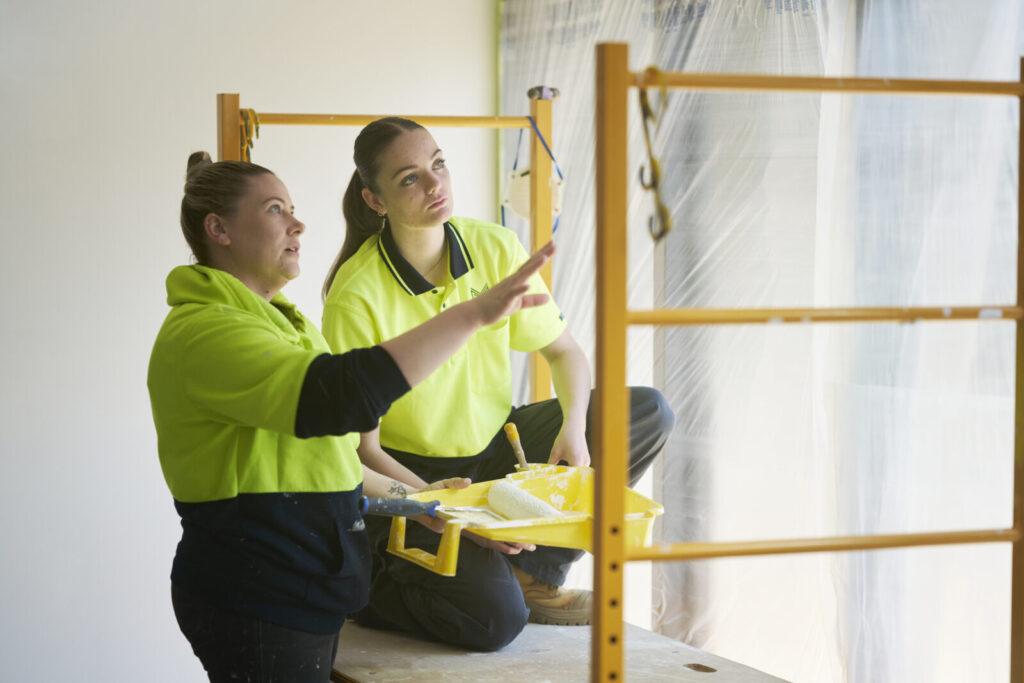Building company owner, registered builder and carpenter Ashleigh Hiemstra, who was last year crowned Tradeswoman of the Year at the HIA Awards, shares her journey into the construction industry and why it was starting a family that gave her the push to go out on her own.

Becoming a builder
“I made the choice to take [my company] Merge Building further after the birth of my son,” Ashleigh says. “I liked that working for myself meant I had the flexibility in my schedule to have some home, work and mum life balance.”
That’s not the average response to motherhood. But nothing about Ashleigh Hiemstra is average. She’s a registered building practitioner, qualified carpenter, the award-winning owner of residential building company, Merge Building, and a mentor to other young women coming up in the industry. So how did she get there?
Ashleigh’s path to becoming a business owner
“I grew up around the building industry,” she says. “My mum was a builder in the early 1990s and my dad is a roof carpenter. During my gap year, I started to think about my future. I knew I wanted to be a builder. It’s as simple as that. I applied to study a Diploma of Building and Construction (Builders Registration) at TAFE.
“Once I completed my diploma, I decided to do an apprenticeship in carpentry and joinery with my family’s business,” Ashleigh continues. “I knew I needed seven years’ practical experience in the trade to be eligible to apply for my building practitioner license. I completed my apprenticeship in early 2014 and continued working with the family business as a qualified roof carpenter.”
While she loved the skills and knowledge she gained as a carpenter, Ashleigh had bigger plans. “It was always my goal to be a builder. Once I was eligible to apply for my registration, I took the steps to start my own company.”
Building resilience
As a woman now firmly established in the industry, Ashleigh talks about the importance of building resilience. As an apprentice, she felt she constantly had to prove herself.
"Every new site is like starting fresh, with people watching to see if you know what you're doing," she said. Rather than being ground down by it, Ashleigh thrives on going the extra mile.
"That extra effort builds your reputation and shows people what you're capable of."
Becoming a mentor
It’s this can-do attitude that has made her a sought after mentor, with schools and TAFEs reaching out to her, and other women interested in the building and construction industry being inspired by her path.
"I didn't realise just how many women were watching, looking for someone like them in trades," she said. “Mentoring and having a support network is very important.” Now in a position to pay it forward, she recently took on a work experience student who is now pursuing a pre-apprenticeship at TAFE. "It's so rewarding to see her doing well and being offered opportunities. I love supporting and mentoring other tradies coming in. It’s been really good to have someone to showcase what is possible in the industry.”
Industry support
One thing Ashleigh wants to emphasise is that the construction industry can be a supportive, welcoming place for women. "There's been a huge shift as the older generation retires," she says. If anything, being a female can be a selling point.
"I'm fine being called a 'female builder' — it's a marketing advantage. Women bring different strengths to the job and that cautious approach often makes us better tradespeople because we avoid careless mistakes."
Role Model for her son
Breaking the mold and proving that the construction industry has a place for everyone has a knock-on effect for the next generation too.
“My son's main role model for a builder is his mum, and I love that."
Is becoming a builder worth it?
With seven years of training behind her, is becoming a builder’s apprentice worth it? “To see a project completed always gives me personally a great sense of achievement. The careers [in construction] are endless and there are so many ways to get into the industry, from an apprenticeship and TAFE to university.
“I found it daunting at first, especially in the first year of my apprenticeship. But soon my confidence grew, and I loved the work I was doing. The variety and daily challenges you are faced with means every project is different. I love the skills and knowledge I have learnt and I love putting my skills to use in everyday life.”
Does Ashleigh have any final words of advice for anyone considering the construction industry? “Go for it!”
If you’re interested in a career in construction, contact CTF to learn about pathways into the industry. There are a number of pathways and school-based traineeships available, as well as other routes and financial support.
Last modified on:

